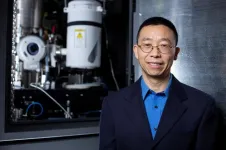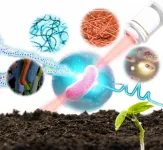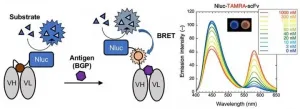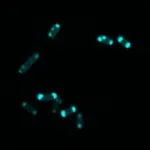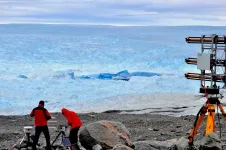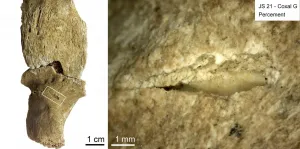(Press-News.org) AMES, Iowa - Materials engineers don't like to see line defects in functional materials.
The structural flaws along a one-dimensional line of atoms generally degrades performance of electrical materials. So, as a research paper published today by the journal Science reports, these linear defects, or dislocations, "are usually avoided at all costs."
But sometimes, a team of researchers from Europe, Iowa State University and the U.S. Department of Energy's Ames Laboratory report in that paper, engineering those defects in some oxide crystals can actually increase electrical performance.
The research team - led by Jürgen Rödel and Jurij Koruza of the Technical University of Darmstadt in Germany - found certain defects produce significant improvements in two key measurements of electrical performance in barium titanate, a crystalline ceramic material.
"By introducing these defects into the material, we can change, modify or improve the material's functional properties," said Xiaoli Tan, an Iowa State professor of materials science and engineering and a longtime research collaborator with Rödel.
In this case, the engineered defects led to a five-fold increase in dielectric properties (that restrict the flow of current) and a 19-fold increase in piezoelectric properties (that internally generates an electric field when subject to mechanical stress), Tan said.
Special tools for special measurements
In addition to Tan, two other Iowa State researchers helped the project's international research team explore fundamental materials questions: Lin Zhou, a scientist in materials science and engineering and the U.S. Department of Energy's Ames Laboratory; and Binzhi Liu, a doctoral student in materials science and engineering.
With support from the National Science Foundation, the three contributed their expertise in transmission electron microscopy - technology that can show the structures and features of materials by shooting a beam of electrons through thin samples and recording an image. The images have much higher resolution than light microscopy and can show fine details down to the scale of individual atoms.
Key to the project was the Ames Laboratory's Sensitive Instrument Facility built in cooperation with Iowa State. The building was built in 2015 with nearly $10 million from the Department of Energy. It provides a vibration- and static-free environment for electron microscopy at the highest possible resolutions.
"It's a state-of-the-art electron microscopy facility," Zhou said. "It provides an ultra-stable environment so we can achieve atom-level images of material and at the same time acquire chemical information.
"It's a great platform for research and educating the next generation of materials scientists."
A better material for capacitors?
For this project, the electron microscopy team quantified the evidence that line defects in a crystalline material can boost electrical performance, Liu said.
The numbers showed that "the dislocations can significantly alter the behavior of other fine features in the material," Liu said.
Tan said the finding could have big implications for the electrical capacitor industry.
There are hundreds of capacitors in your cell phone and the market for them is huge, Tan said. The ceramic material tested in this project has been widely used in capacitors, but the defect-induced boost in electrical performance could make it better. It is also lead-free and less-toxic than other material options.
And so, the researchers wrote, these engineered line defects could turn into "a different suite of tools to tailor functional materials." And this "functional harvesting" could be good for our electronics, and even our environment and health.
INFORMATION:
Read the paper
"Control of polarization in bulk ferroelectrics by mechanical dislocation imprint," Science, May, 28, 2021.
The research team
Iowa State University: Xiaoli Tan, Binzhi Liu
Iowa State/Ames Laboratory: Lin Zhou
Technical University of Darmstadt, Germany: Marion Höfling, Xiandong Zhou, Enrico Bruder, Fangping Zhuo, Bai-Xiang Xu, Karsten Durst, Jurij Koruza, Jürgen Rödel
EPFL, the Swiss Federal Institute of Technology in Lausanne: Lukas Riemer, Dragan Damjanovic
Delft University of Technology, Netherlands: Pedro Groszewicz
Researchers from the Single-Cell Center at the Qingdao Institute of Bioenergy and Bioprocess Technology (QIBEBT) of the Chinese Academy of Sciences have developed a technique to sort and sequence the genome of bacteria in soil one bacterial cell at a time, while also identifying what its function is in the soil environment.
Their study was published in the journal mSystems on May 27.
Soil is home to a vast and complex microbiome, which features arguably the highest genomic diversity and widest heterogeneity of metabolic activities of cells on Earth. In turn, these metabolic activities can in principle provide the foundation for industrial production of numerous compounds of value.
The ability to pinpoint ...
Immunosensors are widely used in immunoassays to detect antigens. One such immunosensor is a quenchbody (Q-body), which contains a modified antibody fragment with a quenched fluorescent dye. When an antigen binds to the Q-body, the dye leaves the antibody and the fluorescence intensifies. The change in fluorescence intensity is easy to measure, making Q-body-based antigen detection systems incredibly simple. However, this method requires an external light source to excite the electrons in the fluorescent dye to produce luminescence.
One way to solve this is to induce luminescence by an alternative method. To achieve this, researchers ...
EUGENE, ORE. -- May 27, 2021 -- Climate skeptics who aren't persuaded by the existing evidence from climate change are unlikely to change their minds for many years, according to a newly published quantitative study by a University of Oregon environmental economist
The central question posed by the study published in the journal Climate Change was "How much evidence would it take to convince skeptics that they are wrong?" The answer depended on the degree of skepticism. The study modeled two types of hypothetical skeptics -- those who were less extreme and believed the change in temperature was slight, as well as ...
While earlier research has mostly looked into factors such as fear, perceived risk, age and political views to determine what makes individuals and societies more or less willing to drastically change their lifestyle and support government-imposed strict restrictions, in order to mitigate the spread of the COVID-19 pandemic, psychologists at the University of Zurich Charlotte Kukowski, Katharina Bernecker and Veronika Brandstätter took a different perspective.
Instead, they chose to find out the impact of people's perception of others' behaviour when it comes to the public good, as well as people's own self-control in sticking to behaviour guidelines. By using data from the United Kingdom and Switzerland, they concluded that, ...
AUSTIN, Texas -- In the perpetual arms races between bacteria and human-made antibiotics, there is a new tool to give human medicine the edge, in part by revealing bacterial weaknesses and potentially by leading to more targeted or new treatments for bacterial infections.
A research team led by scientists at The University of Texas at Austin has developed chemical probes to help identify an enzyme, produced by some types of E. coli and pneumococcal bacteria, known to break down several common types of antibiotics, making these bacteria dangerously resistant to treatment.
"In response to antibiotic ...
New York, NY--May 27, 2021--While our facial expressions play a huge role in building trust, most robots still sport the blank and static visage of a professional poker player. With the increasing use of robots in locations where robots and humans need to work closely together, from nursing homes to warehouses and factories, the need for a more responsive, facially realistic robot is growing more urgent.
Long interested in the interactions between robots and humans, researchers in the Creative Machines Lab at Columbia Engineering have been working for five years to create EVA, a new autonomous robot with a soft and expressive ...
Reanalysis of the prehistoric cemetery Jebel Sahaba (Sudan), one of the earliest sites showing human warfare (13,400 years ago), suggests that hunter-fisher-gatherers engaged in repeated, smaller conflicts. The findings are published in Scientific Reports. Healed trauma on the skeletons found in the cemetery indicates that individuals fought and survived several violent assaults, rather than fighting in one fatal event as previously thought.
Isabelle Crevecoeur and colleagues reanalysed the skeletal remains of 61 individuals, who were originally ...
Shortly before Jakobshavn Isbræ, a tidewater glacier in Greenland, calves massive chunks of ice into the ocean, there's a sudden change in the slushy collection of icebergs floating along the glacier's terminus, according to a new paper led by the Cooperative Institute for Research in Environmental Sciences (CIRES) at CU Boulder. The work, published in Nature Geoscience, shows that a relaxation in the thick aggregate of icebergs floating at the glacier-ocean boundary occurs up to an hour before calving events. This finding may help scientists better understand future sea-level rise scenarios and could also help ...
Since its discovery in the 1960s, the Jebel Sahaba cemetery (Nile Valley, Sudan), 13 millennia old, was considered to be one of the oldest testimonies to prehistoric warfare. However, scientists from the CNRS and the University of Toulouse - Jean Jaurès (1) have re-analysed the bones preserved in the British Museum (London) and re-evaluated their archaeological context. The results, published in Scientific Reports on May 27, 2021, show that it was not a single armed conflict but rather a succession of violent episodes, probably exacerbated by climate change.
Many individuals buried at Jebel Sahaba bear injuries, half ot them caused by projectiles, the points of which were found in the bones or the fill where the body was located. The ...
What The Study Did: The findings of this systematic review and meta-analysis indicate that enhanced personal protective equipment is associated with low rates of SARS-CoV-2 transmission during tracheostomy.
Authors: Phillip Staibano, M.Sc., M.D., of McMaster University in Ontario, Canada, is the corresponding author.
To access the embargoed study: Visit our For The Media website at this link https://media.jamanetwork.com/
(doi:10.1001/jamaoto.2021.0930)
Editor's Note: The article includes conflict of interest disclosures. Please see the article for additional information, including other authors, author contributions and affiliations, conflict of interest and financial ...
